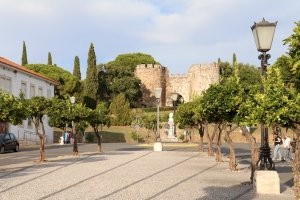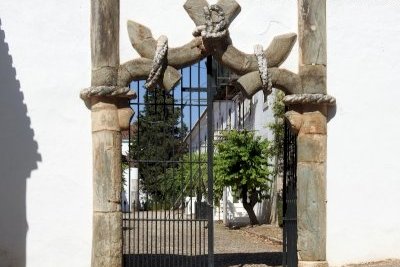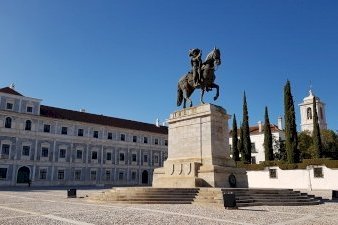Portugal
Vila Viçosa
Vila Viçosa gained its historical importance as the residence of the noble dynasty of the House of Braganza.
The Ducal Palace was completed in 1507 and rebuilt in the Mannerist style between the 16th and 17th centuries. The townscape is characterized by the intensive use of marble from the local deposits. The property also includes the Tapada Real, the former royal game hunting reserve.
Site Info
Official Information
- Full Name
- Vila Viçosa (ID: 6214)
- Country
- Portugal
- Status
-
Nominated 2027
Site history
History of Vila Viçosa
- 2017: Revision
- Includes former TWHS Chateau de Vila Vicosa (1982-1996)
- 2017: Added to Tentative List
- Added to tentative list
- Type
- Cultural
- Criteria
- ii
- iv
Links
- UNESCO
- whc.unesco.org
All Links
UNESCO.org
- whc.unesco.org — whc.unesco.org
Community Information
- Community Category
- Human activity: Urban planning
Travel Information
Recent Connections
News
No news.
Recent Visitors
Visitors of Vila Viçosa
- AC
- Adolfo
- alex
- Ammon Watkins
- Argo
- Bin
- Christoph
- Christravelblog
- CugelVance
- Dimitar Krastev
- Dr. Caligari
- Els Slots
- FS
- Hadrianus
- Hubert
- Jakob F.
- Javier
- Jean Lecaillon
- Jonas Kremer
- Krzysztof B
- Kurt Lauer
- lichia
- MarcoB_0
- M. Huineman
- nan
- Patrik
- Porcho
- Roman Bruehwiler
- Sergio Arjona
- Stanislaw Warwas
- Szucs Tamas
- Tarquinio_Superbo
- Thomas van der Walt
- tony0001
- usagi1974
- Wojciech Fedoruk
- Xiquinho Silva
Community Reviews
Show full reviews
I visited the pleasant small city of Vila Vicosa on oct. the 6th,2024, stayed there overnight, and left at 8.00 a.m the following day, on oct.the7th.
First of all...
V.V is the kind of place that you like to visit, that is pleasant, that pleases you, but that doesn't really stay in your memory for long.
I travelled by bus from Lisboa's Sete Rios bus station and arrived around 11.00 in V.V.
My rented apartment was just a stone's throw from V.V's castle,the Castelo do Vila Vicosa, and its archaeological and hunting museum. I visited the inside of the castle and its museums later that day. The impressive hunting museum alone justifies the entrance fee.
I climbed the accessible castle walls and walked on them as far as I could....great view of the city and the cemetery of the Santuario de Nossa Senhora de Conceicao. I then visited the church itself and its cemetery. Afterwards I quickly went to the Prince's Palace, where I bought a combination ticket for the Ducal Palace and the Augustine Church (Igreja dos Agostinhos)...however, the Ducal Palace is closed at noon and doesn't open again until 2 p.m. I was told that the tour wouldn't start until around 2:20 p.m./2:25 p.m....I should please visit the Augustine Church first. That's what happened and I followed their advise.
The guided tour through the palace was quite interesting and informative, but nothing from another dimension. We were a big group ( sunday, …
Keep reading 0 comments
October 2020 - after spending few hours in Evora we still scheduled a stopover in the marvel town of Vila Vicosa. Already on the way we passed several quarries and trucks which transported the white gold to somewhere. We arrived in the town, parked at the castel and took a walk to the Paco Ducal. The palace is beautiful, the facade shimmers blueish/silver and also a walk through the town reveals some further nice spots. I would not be dissapointed if it should be inscribed.
Definitely good side to squeeze in between Evora and Elvas.
Keep reading 0 comments
Vila Viçosa, which may be up for nomination in 2022, is a town in the south central Portuguese region of the Alentejo. It lies close to the Spanish border, in the sweltering interior of the Iberian Peninsula. All the houses and many of the other buildings here are painted white, the streets are narrow. When I arrived in the afternoon the temperature was 38 degrees Celsius and there was no one to be seen in its streets: the locals know better and there were no tourists.
In the evening I had to leave my airconditioned hotel room to find something to eat. There aren’t many restaurants and nothing opens before half past seven. I ended up at the hippest place in town: Craft BBS - here they sell home-brewed beers and luxury burgers. I was able to get the last table inside, the rest of them both inside and outside were already reserved. Due to the mandatory distance between the tables, they cannot accommodate many guests at this time.
The next morning I tried my best to get to know Vila Viçosa. As a possible future World Heritage Site of Portugal, it is framed as a planned city based on Renaissance ideals. It was the seat of the House of Braganza, which supplied the country with 15 Portuguese kings and 4 Brazilian monarchs until the early 20th century. It has a 14th century castle, from which you have a beautiful view of one of the 2 city’s central …
Keep reading 0 comments
Vila Vicosa was a pleasant stop on our way from Lisbon airport to Elvas WHS. It is a pretty and small town with white houses as you can find dozens in Portugal, nothing special from that point of view. The main point of interest is the Renaissance ducal Palace, which large front side (more than one hundred meters long) stretches on one side of a wide, cobbled square, also bordered by churches and more white buildings.
Vila Vicosa was the hometown of the Dukes of Braganza, one of the most powerful and influential family in Portugal, and who eventually became the last reigning family of the country when Joao IV became king of Portugal. Almost 150 years before they took the throne, the ducal palace was already a clear manifesto of their power, built by Duke Jaime I at the very beginning of 16th century, as he wanted to get out of the old, medieval castle, which had been the home of his fathers. Front side of the palace has clear Renaissance style, while most of the rooms inside have been changed and refurbished over the centuries: mainly the global layout and the ceiling in few rooms survived. The visit is by guided tour only (for about 50 minutes), and in Portuguese. Luckily, our guide was excellent and was speaking very distinctly, so if you speak another Latin language, as we do, you are likely to understand most of the explanations. Those are mainly about portraits and object that …
Keep reading 0 comments
